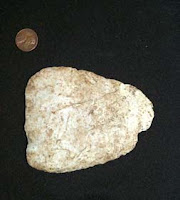A Step Back in Time at Yellow Banks Park
American Indian influence has been
discovered throughout our park system here in Polk County but none as evident
as in Yellow Banks Park. Nestled within the very southeast corner of the county
lies this 557-acre recreation area overlooking the Des Moines River. Named for
the rich yellow loess soil deposited along the banks, this river valley
landscape was home to several native cultures such as Paleo-Indians and the
Oneota. Evidence of their presence along the river points to a productive area
capable of sustaining populations since the retreat of the last glacier that
covered portions of Iowa as recently as 10,000 - 13,000 years ago.
What makes Yellow Banks Park such a unique piece of land is the convergence of various landscapes in this one area which sits right on the cusp between the Southern Iowa Drift Plain and the Des Moines Lobe above the Des Moines River Valley (carved out by glacial meltwater). The park derives its name from the yellow loess soils that have accumulated at this site since the Illinoian glaciation.The park represents a rather dissected landscape ranging from high-dry loess landscape down into deep, moist valleys. This deeply incised river valley landscape was a prime location for early native people who were attracted to the biologically productive bluffland features which provided the natural resources required by native deep wood river and prairie savanna communities alike. From this place arose a civilization from which we are able to catch glimpses of through archaeological finds.
When the park was first obtained by
Polk County Conservation in 1980, the state archaeologist was hired to survey
Yellow Banks for artifacts and significant areas. What was found of
significance were Native American burial mounds scattered throughout the area.
Only one mound remains intact as several mounds were removed when the Red Rock
Reservoir was formed and a railway line was moved up on the bluff. Since
then, more deliberate care has gone into managing this area when projects are
planned out.
Indigenous People of Iowa Timeline
Paleo-Indians (9,500-7,500 BC)
 |
| Clovis Projectile Point |
Paleo-Indians were wandering buffalo hunters. They followed big game through a cool, wet, forested post-glacial landscape. These people left behind leaf-shaped spear points, stone knives, and hide scrapers. These tools were used in hunting, butchering game, and dressing hides.
Archaic-Indians (7,500-500 BC)
 | |
| Butterfly Banner Stone |
Woodland-Indian (500 B.C. – 1000 A.D.)
 |
| Stone Knife - cutting and skinning |
The Woodland people were hunters, gathers, and gardeners. In small garden plots they grew sunflowers, pigweed, goosefoot, and marsh elder for their edible seeds. Later, the woodland people grew corn, beans, squash and tobacco. These crops were imports from Mexico.
Woodland hunters used spear points with corner notching at the base. About 400 AD the bow and arrow was developed. Hunters began killing game with arrows tipped with one inch long triangle points.
The Woodland people made the first pottery in this area. Pots were made with clay that had grit or sand added to it as a tempering agent. A tempering agent helps to keep pottery from cracking while it is air drying. Later the pots were “fired” in a wood fire. The outside of the pots were often decorated with cord markings.
The Woodland people made the first pottery in this area. Pots were made with clay that had grit or sand added to it as a tempering agent. A tempering agent helps to keep pottery from cracking while it is air drying. Later the pots were “fired” in a wood fire. The outside of the pots were often decorated with cord markings.
Indian mounds were built by the Woodland people. These large earth monuments were built on bluff tops overlooking a major river. They were often circular in shape. Human burials, stone tools, and pottery were often placed in Indian mounds.
 |
| Hide Scraper |
The Oneota people spent their time hunting, fishing, plant collecting and farming. They lived in villages of bark covered longhouses located along major rivers. In small fields on the floodplain the Oneota grew native varieties of corn, beans, squash, and sunflowers. After the crops were started and hoed a few times, the people would leave on seasonal buffalo hunts. They also collected edible wild plants. The Oneota people left behind some characteristic artifacts such as celts or grooveless axes, clay pots made with ground clam shell tempering, and one-inch triangular arrow points. Grinding slabs for processing corn have also been found. This group of people lived in Iowa into the historic period where they were known as the Ioway Indians.
Generations of indigenous peoples lived, died and shaped our landscape right here in Iowa. Their ways of life are still reflected in remnant village and burial sites scattered across Polk County and the river valleys of Iowa. We can learn a great deal about ourselves and how we relate to where we live by respecting and studying those who have come before us.
Ready to learn more?
Join Polk County Conservation naturalists on Saturday, November 14th at Yellow Banks Park (meet in the tent camping area) from 1:00 - 3:00 p.m. for Native American History Day.Get hands on experience constructing a tipi and try your hand at throwing an atlatl. Don’t know what and atlatl is? Join us and find out. Authentic artifacts collected from the area and rarely seen by the public will be interpreted. The artifacts span over twelve thousand years of history and represent four different cultures. We’ll also take a short hike to the last remaining burial mound in the park. This event is free and all ages are welcomed.


Comments
Post a Comment